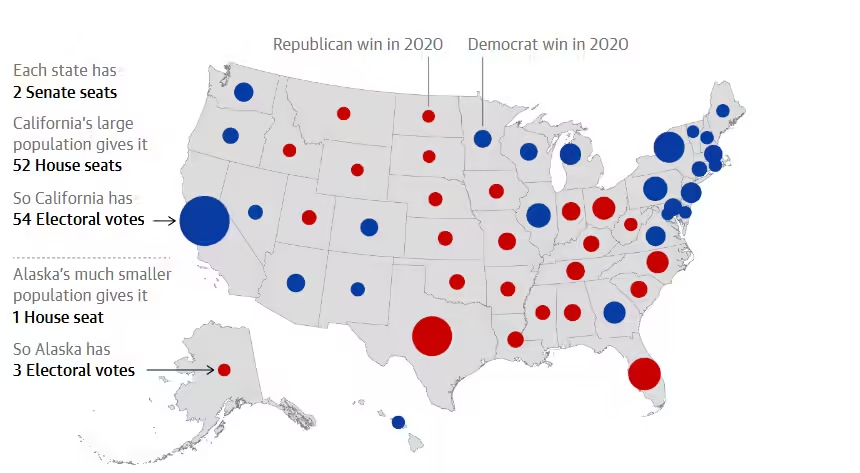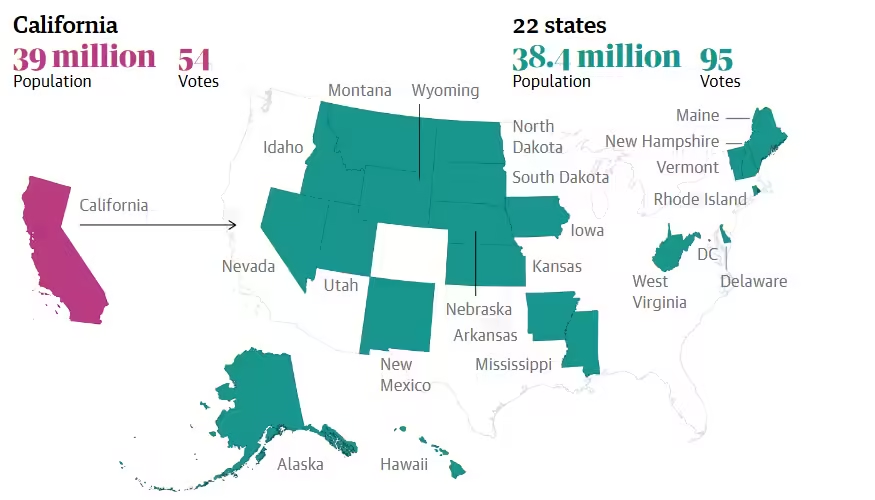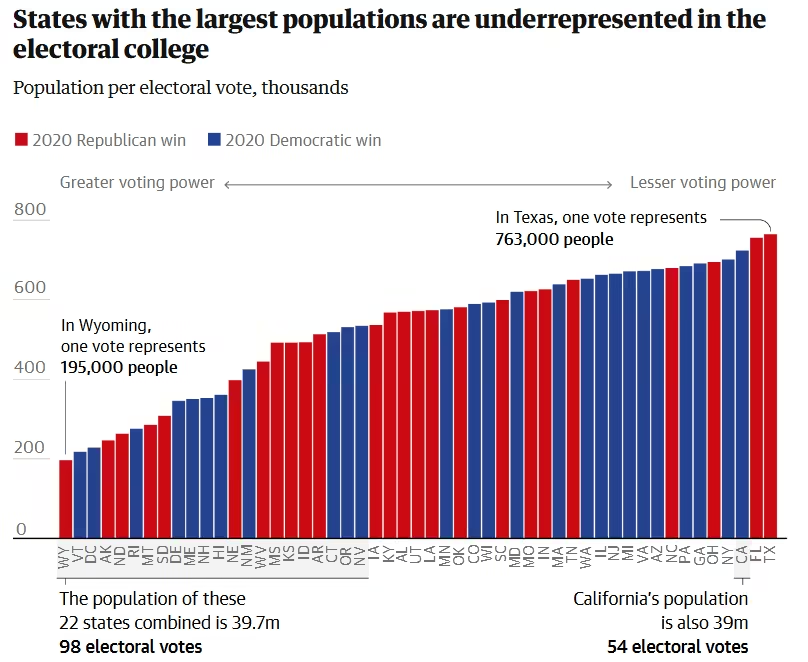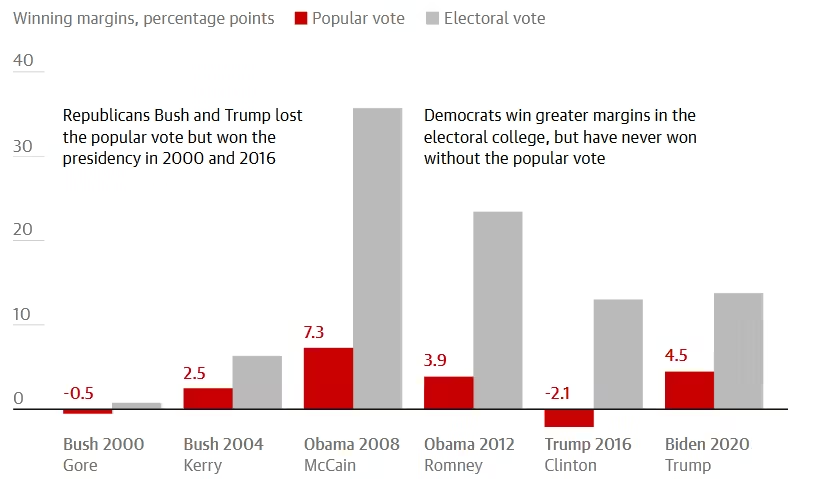US electoral college: Here are some things to be aware of when members of the electoral college gather in each of the 50 states to cast their votes every four years.
The Awadh Times: Despite claiming to be one of the world’s most democratic nations, the United States does not allow its citizens to directly elect its president. The electoral college, the complicated process by which Americans have chosen their president since the 18th century, is responsible for that responsibility.
The Us electoral college is more of a procedure than a body, despite its name. Its members, who include politicians and mostly unidentified party supporters, gather in all 50 states on the same day every four years to vote for the president. After that, they practically vanish.
The fact that two Republican presidents, Donald Trump in 2016 and George W. Bush in 2000, were elected president despite losing the popular vote has contributed to the growing criticism of the electoral college in recent years. However, there is little indication that the US elections will be different very soon.
Here is all the information you require.
The US electoral college: what is it?
The election of a president is outlined in Article II of the US Constitution.
The number of electors in each state is equal to the number of senators and representatives that state has in Congress. Three electoral votes are awarded to Washington, DC. There are 538 electors in all. To win, a candidate must receive 270 of them, or a simple majority.
The number of electoral votes allotted to each state is based in part on its population.

Each state’s Senate and House seats add up to its electoral votes.
Photo Credit: The Guardian
According to the constitution, state legislatures are free to decide how to distribute electors. A winner-take-all system, in which the state’s popular vote winner receives all of the electoral votes, has long been the choice of all but two states.
Two states, Maine and Nebraska, award their electors in separate ways, which further complicates things. The statewide victor in each state receives two electoral college votes. The winner in each state’s congressional district then receives the remaining electors from each state, which are three in Nebraska and two in Maine.
Read More:
Sofia Ansari Biography, Controversies, Career, and Social Media Journey in 2024
Why is there an electoral college in the United States?
The founding fathers struggled to come up with a mechanism for selecting a chief administrator when they convened in Philadelphia in 1787 to establish the US constitution. At first, they suggested a system in which the president would be chosen by Congress. However, that raised worries that the executive branch, which is supposed to be separate from Congress, would be governed by it.
Additionally, some of the delegates supported a direct popular vote to choose the president. However, the historian Alexander Keyssar noted in his book Why do we still have the electoral college that the notion never gained widespread favor and was frequently rejected during the convention.
The concept was not very well-liked for several reasons. First, the racist three-fifths compromise was established by the convention, according to which slaves were considered three-fifths of a person for population considerations. Slaves comprised a significant portion of the population in the southern states, therefore this was a victory for them. Due to their smaller voter bases, the southern states would have been at a disadvantage under a popular vote system.

Despite having fewer people than California, the 22 least populous states collectively hold a significantly higher number of electoral votes.
According to Keyssar, there were also worries about handing bigger states too much influence and that voters wouldn’t be able to find out about the candidates from other states. He writes that the argument was motivated more by practical considerations than by political rights.
How to choose the president was one of the unsolved issues that a committee of eleven delegates was tasked with addressing toward the end of the conference. They put forward a variant of the electoral college as we know it now.
The Constitution’s system of presidential elections, Keyssar noted, “embodied a web of compromises, spawned by months of debate among men who disagreed one another and were uncertain about the best way to proceed.” This little nativity story clarifies this point. “It was essentially a second-choice consensus, which was made acceptable in part by the incredibly intricate electoral details, which in turn represented concessions to or gestures toward specific constituencies and convictions.”
A swing state: what is it?
“Swing states” are states where any presidential candidate has a strong chance of winning.
Pennsylvania (19 electoral votes), Wisconsin (10 electoral votes), Michigan (15 electoral votes), Georgia (16 electoral votes), North Carolina (16 electoral votes), Arizona (11 electoral votes), and Nevada (six electoral votes) are the seven swing states in the 2024 election. The candidates will concentrate most of their time and resources in those states since whoever wins the election will have to carry some combination of those states. In the 2020 election, Joe Biden won all of them states except North Carolina.
Additionally, shifting demographics might cause the concept of a swing state to evolve over time. For instance, Florida and Ohio were seen as swing states until recently, but they are now firmly Republican. Prior to Donald Trump’s victory in 2016, Michigan was regarded as a fairly stable Democratic bastion.

Photo Credit: The Guardian
Can minority rule be implemented through the electoral college?
Black-and-white composite of Kamala Harris on the right and Donald Trump on the left.
What positions do Trump and Harris have on the main election issues?
Five US presidential elections have occurred in which the victor did not receive the majority of the popular vote: 1824, 1876, 1888, 2000, and 2016. As a result, more people are now aware of the system’s inequities, and some are advocating for the electoral college’s complete elimination.
The most vocal objection is that the system weakens the impact of a presidential vote based on a person’s residence. In California, one elector is representative of almost 726,000 individuals. An elector in Wyoming is somewhat more than 194,000 people.
The candidate with fewer votes won two of the previous six elections.

Photo Credit: The Guardian
The system’s ability to let a small percentage of Americans decide the outcome of the presidential election is another point of criticism. In 2020, Biden won the electoral college with roughly 44,000 votes from Wisconsin, Georgia, and Arizona. In an election with 154.6 million votes, such a narrow margin is remarkable.
In 2016, Trump’s winning margins in crucial swing states came from a total of roughly 80,000 votes.
Read More:
How Nehru defeated Sardar Patel to become Congress president
Are electors required to support a particular candidate?
Electors are chosen by state political parties based on their belief that they are party loyalists who will only vote for the party’s nominee. However, voters have sometimes voted for other candidates. Seven electors, for instance, cast ballots for candidates other than the ones they had promised to support in 2016. The National Conference of State Legislatures said it was the first time since 1972 that an elector had shown disloyalty.
Voters are required by law in several states to support the candidate they have vowed to support. The US Supreme Court ruled in 1952 that states had the authority to force voters to support the party’s nominee. Additionally, the court ruled in 2020 that states could punish electors who fail to support the candidate they have vowed to support.
What is the reason behind the electoral college’s prolonged existence?
There have been attempts to alter the electoral college since nearly immediately after it was established. “Within a little over ten years of the constitution’s ratification, there were constitutional amendments being promoted,” Keyssar stated. Since 1800, there have likely been at least 1,000 constitutional amendments submitted to amend or repeal the document. A few of them are near to (The Congressional Research Service reports that as recently as 2019, there were over 700 attempts.)
Keyssar claimed that southern states protested when the proposal for a nationwide popular vote was made in 1816. Although they were unable to vote, slaves nonetheless gave them influence in the electoral college. He claimed that they would forfeit the additional money they received on behalf of their slaves.
Although African Americans had a legal right to vote following the Civil War, southern governments persisted in preventing them from doing so. They remained in favor of the electoral college system because a nationwide popular vote would have reduced their impact on the final result.
Once, in the late 1960s, the nation came very close to doing away with the electoral college. The system was on the verge of collapse in 1968 when segregationist governor George Wallace of the South nearly received enough votes to deny any contender a majority in the electoral college. The proposed amendment was approved by the US House 339 to 70. However, senators from southern states filibustered the bill, causing it to stall in the Senate.
According to the Washington Post, this resulted in ongoing opposition to a national popular vote in order to preserve the influence of southern whites. The idea was finally approved by President Jimmy Carter, but in 1979 it was not supported by enough senators, including Joe Biden.
Keyssar remarked, “It’s not like we’re just now realizing this system doesn’t work.”
Is it currently possible to abolish the US electoral college?
The National Popular Vote Interstate Compact is currently the most well-known attempt to abolish the electoral college. The goal is to persuade states to provide their electors to the national popular vote winner, regardless of how their state turns out. When states with a combined total of 270 electoral votes—enough to decide the election winner—join, the compact will go into effect.
209 electoral votes, or 17 states and Washington, DC, have joined the campaign thus far.
However, the project’s future is unclear. The governor or legislature of almost every state that hasn’t joined is Republican. Additionally, legal experts have questioned the constitutionality of such an arrangement, a subject that would likely be swiftly brought before the US Supreme Court.

